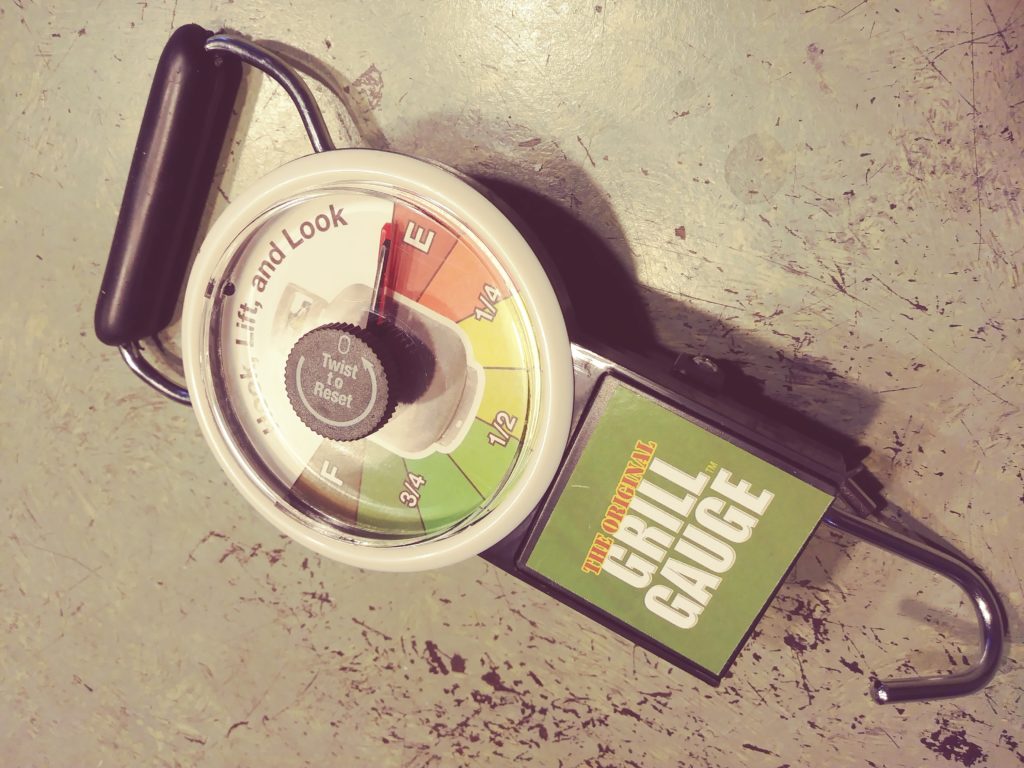A vital part of my Hurricane supplies is a stockpile of full 20 pound propane tanks. I depend on these to run my dual fuel electric generator, as well as for use with a camp stove. One thing that always bothered me was not knowing how much fuel is actually inside those heavy metal tanks.
What good is a nearly empty tank when you are depending on it in an emergency…
On YouTube, I have watched people pour cold water or hot water over the side of tanks, in order to detect the level of the liquid inside. However, I find that a messy process, involving some element of guess work.
I always wondered why they didn’t build in some sort of fuel gauge on each tank?
Well, I recently found a low-cost and simple to use device, called the Grill Gauge, that does the trick. It gives a repeatable reading every time you measure a tank.
The little Grill Gauge device is a great way to find out how much propane is left inside your 20 pound propane tank. We use this ourselves and it really takes the guesswork out of it. Now I know of the refill or exchange tank is full.

We have a propane powered generate and keep 5 or 6 tanks worth of fuel on hand at all times.
Now that we have seen the Grill Gauge demonstration, let’s look more closely at how a propane tank works:
- An empty propane tank, like those pictured in this post, have an empty weight of about 17 pounds.
- The empty weight is called the tare weight, and all tanks have a “tare weight” or “T.W.” stamped on the collar of the tank.
- When a tank is filled, the total weight should be equal to the tare weight + 20 pounds of fuel. That should be 17 pounds + 20 pounds = 37 pounds (approximately).
- 1 gallon of propane weighs 4.2 pounds
- The average 20 pound tank holds about 4.7 gallons of propane.
- The tanks have a 20% buffer to account for heat related expansion of the fuel, so the actual amount of fuel you get depends on the air temperature.
Tanks can be refilled many times. Places like U-Haul and Ace Hardware will fill tanks for somewhere between $3 to $4 a gallon.
You can exchange Empty propane tanks for full ones. Stores like Home Depot, Walmart, and Lowe’s have some of the cheapest exchange prices. Even neighborhood 7-Eleven type stores often have exchange tanks (usually at a higher price). To do an exchange, you bring your empty in and get a different full tank back.
TIP – One way I have gotten additional tanks is to watch Craigslist for people selling old tanks for really cheap prices ($5 – $10 each). Even old, rusted tanks can be exchanged. You just bring in any tank, exchange it, and walk away with a tested and safely filled tank. The companies test every changed tank, and recycle the metal for any that are too old or damaged. I got a couple empty tanks for free when my neighbor cleaned out his shed. They were junk to him, but where like gold to me.
Jamie, Your Hunker Down Guide
A new empty tank can cost anywhere from $25 to $40 at the big box stores. You can often find sales, so watch the ads. Honestly, I looked over the tanks on Amazon and it looks like they are much more expensive than any you can buy locally. They only ship empty ones too, so you would have to take it to get filled anyway. You might as well buy local.
The time to assemble your stockpile of tanks and get them filled is before the panic buying that happens when a hurricane or tropical storm is forecast to hit. I have seen the tank exchanges and new tank shelves all cleared of every available tank.
Recommendation based on our first hand experience: Grill Gauge does the job perfectly
Be sure to store your propane tanks properly, following all safety requirements. We will get into a solution for that in a later post.
If you are new to our site and need a jump-start on preparing for a hurricane, download your free 22 page PDF workbook “Essential Hurricane Kit & Records Planner”.
